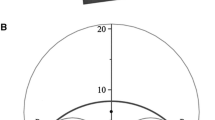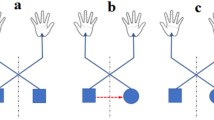Abstract
There is extensive experimental evidence linking instantaneous velocity to curvature in drawing and hand-writing movements. The empirical relationship between these characteristics of motion and path is well described by a power law in which the velocity varies in proportion to the one-third power of the radius of curvature. It was recently shown that a similar relationship can be observed during locomotion along curved elliptical paths raising the possibility that these very different motor activities might, at some level, share the same planning strategies. It has, however, been noted that the ellipse is a special case with respect to the one-third power law and therefore these previous results might not provide strong evidence that the one-third power law is a general feature of locomotion around curved paths. For this reason the experimental study of locomotion and its comparison with hand writing is extended here to non-elliptical paths. Subjects walked along predefined curved paths consisting of two complex shapes drawn on the ground: the cloverleaf and the limacon. It was found that the data always supported a close relationship between instantaneous velocity and curvature. For these more complex paths, however, the relationship is shape-dependent—although velocity and curvature can still be linked by a power law, the exponent depends on the geometrical form of the path. The results demonstrate the existence of a close relationship between instantaneous velocity and curvature in locomotion that is more general than the one-third power law. The origins of this relationship and its possible explanation in the mechanical balance of forces and in central planning are discussed.




Similar content being viewed by others
References
Abend W, Bizzi E, Morasso P (1982) Human arm trajectory formation. Brain 105:331–348
Cavagna GA, Margaria R (1966) Mechanics of walking. J Appl Physiol 21:271–278
Cheron G, Draye JP, Bengoetxea A, Dan B (1999) Kinematics invariance in multi-directional complex movements in free space: effect of changing direction. Clin Neurophysiol 110:757–764
Courtine G, Schieppati M (2003) Human walking along a curved path. I. Body trajectory, segment orientation and the effect of vision. Eur J Neurosci 18:177–190
de’Sperati C, Viviani P (1997) The relationship between curvature and velocity in two-dimensional smooth pursuit eye movements. J Neurosci 17:3932–3945
Flash T, Hogan N (1985) The coordination of arm movements: An experimentally confirmed mathematical model. J Neurosci 5:1688–1703
Grasso R, Glasauer S, Takei Y, Berthoz A (1996) The predictive brain: anticipatory control of head direction for the steering of locomotion. Neuroreport 7:1170–1174
Grasso R, Prevost P, Ivanenko YP, Berthoz A (1998) Eye-head coordination for the steering of locomotion in humans : an anticipatory strategy. Neurosci Lett 253:115–118
Greene PR (1985) Running on flat turns : experiments, theory, and applications. J Biomech Eng 107:96–103
Gribble PL, Ostry DJ (1996) Origins of the power law relation between movement velocity and curvature: modeling the effects of muscle mechanics and limb dynamics. J Neurophysiol 76:2853–2860
Harris MH, Wolpert DM (1998) Signal-dependant noise determines motor planning. Nature 394:780–784
Imai T, Moore ST, Raphan T, Cohen B (2001) Interaction of body, head, and eyes during walking and turning. Exp Brain Res 136:1–18
Ivanenko YP, Grasso R, Macellari V, Lacquaniti F (2002) Two-thirds power law in human locomotion: role of ground contact forces. Neuroreport 13:1171–1174
Kawato M, Maeda Y, Uno Y, Suzuki R (1990) Trajectory formation of arm movement by cascade neural network model based on minimum torque-change criterion. Biol Cyber 62:275–288
Lacquaniti F, Terzuolo C, Viviani P (1983) The law relating the kinematic and figural aspects of drawing movements. Acta Psychol 54:115–130
Land MF, Lee DN (1994) Where we look when we steer. Nature 369:742–744
Loomis JM, Beall AC (1998) Visually controlled locomotion: its dependence on optic flow, three-dimensional space perception, and cognition. Ecol Psychol 10:271–285
Massey JT, Lurito JT, Pellizzer G, Georgopoulos AP (1992) Three-dimensional drawings in isometric conditions: relation between geometry and kinematics. Exp Brain Res 88:685–690
Reina GA, Schwartz AB (2003) Eye-hand coupling during closed-loop drawing: evidence of shared motor planning? Hum Mov Sci 22:137–152
Richardson MJ, Flash T (2002) Comparing smooth arm movements with the two-thirds power law and the related segmented-control hypothesis. J Neurosci 22:8201–8211
Schaal S, Sternad D (2001) Origins and violations of the 2/3 power law in rhythmic three-dimensional arm movements. Exp Brain Res 136:60–72
Schwartz AB, Moran DW (1999) Motor cortical activity during drawing movements : population representation during lemniscate tracing. J Neurophysiol 82:2705–2718
Sternad D, Schaal S (1999) Segmentation of endpoint trajectories does not imply segmented control. Exp Brain Res 124:118–136
Todorov E, Jordan MI (1998) Smoothness maximization along a predefined path accurately predicts the speed profiles of complex arm movements. J Neurophysiol 80:696–714
Vieilledent S, Kerlirzin Y, Dalbera S, Berthoz A (2001) Relationship between velocity and curvature of a locomotor trajectory in human. Neurosci Lett 305:65–69
Viviani P, Cenzato M (1985) Segmentation and coupling in complex movements. J Exp Psychol Hum Percep Perf 11:828–845
Viviani P, Flash T (1995) Minimum-jerk, two-thirds power law, and isochrony: converging approaches to movement planning. J Exp Psychol Hum Percep Perf 21:32–53
Viviani P, Stucchi N (1989) The effect of movement velocity on form perception: geometric illusions in dynamic displays. Percept Psychophys 46:266–274
Viviani P, Stucchi N (1992) Biological movements look uniform: evidence of motor-perceptual interactions. J Exp Psychol Hum Percep Perf 18:603–623
Viviani P, Terzuolo C (1982) Trajectory determines movement dynamics. Neuroscience 7:431–437
Wann JP, Nimmo-Smith I, Wing AM (1988) Relation between velocity and curvature in movement: equivalence and divergence between a power law and a minimum-jerk model. J Exp Psychol Hum Percep Perf 14:622–637
Warren WH, Kay BA, Zosh WD, Duchon AP, Sahuc S (2001) Optic flow is used to control human walking. Nat Neurosci 4:213–216
Wilkie RM, Wann JP (2003) Eye-movements aid the control of locomotion. J Vision 3:1–9
Willems PA, Cavagna GA, Heglund NC (1995) External, internal and total work in human locomotion. J Exp Biol 198:379–393
Acknowledgements
The authors wish to thank S. Dalbera and T. Ducourant for their technical assistance during the experiments and F. Maloumian for the graphs. This study was supported by a grant “Cognitique Thème Action” from the French Ministry of Research (MENRT).
Author information
Authors and Affiliations
Corresponding author
Rights and permissions
About this article
Cite this article
Hicheur, H., Vieilledent, S., Richardson, M.J.E. et al. Velocity and curvature in human locomotion along complex curved paths: a comparison with hand movements. Exp Brain Res 162, 145–154 (2005). https://doi.org/10.1007/s00221-004-2122-8
Received:
Accepted:
Published:
Issue Date:
DOI: https://doi.org/10.1007/s00221-004-2122-8




